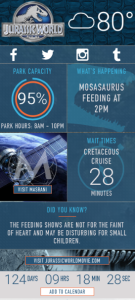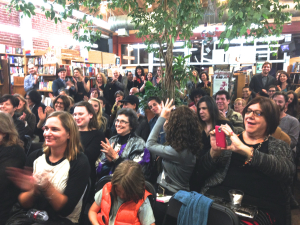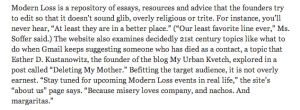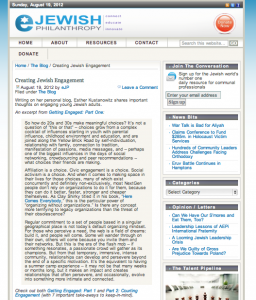Uncategorized

December 1, TVGoneJewy @ American Jewish University
0
Click link to register.
Join me for a special Hannukah/Hanukkah/Chanukah/?? edition of my session delving into Jewish identity on the small screen. We’ll see how many examples we can get through in 60 minutes!
Wednesday, 12/1/2021 @ 12pm-1pm PST – register in advance and the Zoom invitation will be emailed to you 7 days prior.
More about TVGoneJewy: From unscripted bingeworthy shows to nuanced dramas, Jewish writers and content creators are reclaiming and reshaping Jewish identity on-screen, and audiences are reacting to the increased Jewish representation with enthusiasm and worry, alternating between celebration and condemnation. What do we expect from on-screen Jewish representations of secular and religious Jews and their identities? Why is this happening now? How are creators hitting or missing the mark?

My Podcast, The Bagel Report, is an Awards Finalist
0
UPDATE OCTOBER 2021: We placed SECOND! Behind KCRW and ahead of NPR…amazing. 🙂
Thrilled that our The Bagel Report interview featuring Mayim Bialik is a finalist in the Podcast Personality Profile/Interview category at the upcoming SoCal Journalism Awards, sponsored by the L.A. Press Club!
Congrats to all the nominees. Awards will be distributed in October, but it’s just an honor for our little podcast to be a finalist. 🙂
Check out our most recent episode and the nominated episode below!

Rockower Awards for Jewish Journalism – 2nd Place, Arts
0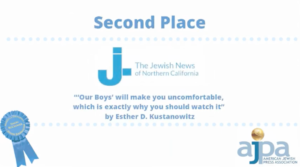 Thrilled to be among the winners for this year’s American Jewish Press Association Rockower Awards, placing second in the arts and criticism, news and features category for this piece I wrote about Our Boys.
Thrilled to be among the winners for this year’s American Jewish Press Association Rockower Awards, placing second in the arts and criticism, news and features category for this piece I wrote about Our Boys.
J. wins record-breaking 12 national Jewish press awards, including General Excellence
‘Our Boys’ will make you uncomfortable, which is exactly why you should watch it
EstherK Explains: Passover
0Need a crash course in Passover? Check out EstherK Explains Passover!

The Marvelous Mrs. Marketing–oops, I Meant “Maisel” (& more!)
0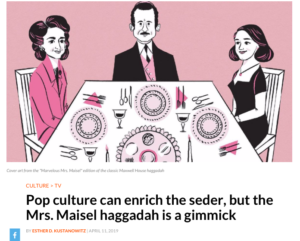 That’s right. I said it. I’m the grinch who stole Passover. I’m the “Marvelous Mrs. Maisel” fan who doesn’t want a Maisel-themed Haggadah for her Passover seder. But I do wish that when these religion-and-pop-culture mashups happen, that they do so in a way that enriches either the religious source material or the pop culture text, and this collector’s edition did neither–it was simply a marketing gimmick. The Maxwell House Haggadah is known for its accessible simplicity. And I can respect that, even if it’s not what I find meaningful during the Passover holiday. But I am the kind of person who likes to dive deep into culture and text, to look for meaning.
That’s right. I said it. I’m the grinch who stole Passover. I’m the “Marvelous Mrs. Maisel” fan who doesn’t want a Maisel-themed Haggadah for her Passover seder. But I do wish that when these religion-and-pop-culture mashups happen, that they do so in a way that enriches either the religious source material or the pop culture text, and this collector’s edition did neither–it was simply a marketing gimmick. The Maxwell House Haggadah is known for its accessible simplicity. And I can respect that, even if it’s not what I find meaningful during the Passover holiday. But I am the kind of person who likes to dive deep into culture and text, to look for meaning.
What might I have done instead? Try to look at the Maisel characters through a Passover lens. Take the Four Children: Wise, Wicked, Simple and Unable to Ask a Question…Midge Maisel (nee Weissman) spends years not knowing how to ask for what she wants, but then gets wise about it, rendering her wicked in the eyes of father, Abe, a wise man (phonetically, Weissman!) whose worldview is rigid and simple. Rose demands her daughter conform to a simpler life, but because she herself doesn’t know how to ask for what she wants, she flees her life (wicked?) and country to reconnect with an old path. And in the newest season, we find out that the son, living a life at a frequency that seemed much simpler than Midge’s, is using that simplicity as a cover for a complicated government life. Maisel characters–and people–are complicated.
For more about how I’d bring pop culture into the Four Children context, check out my latest in the J. And you can check out past pop culture/Passover pieces at my Haggadot.com author page (where you can make your own meaningful Haggadah!)
(Thanks for reading – will try to keep this space more updated in the future.)

Jurassic World: The Transmedia Story Begins
1If you watched the Super Bowl, you probably already saw the ad for Jurassic World, the next sure-to-be-a-blockbuster summer movie in a franchise that continues to ask the question, “if we rebuilt the park AGAIN…would it still be a disaster?” and adds the question, “if we created an even deadlier dinosaur than a T-Rex…would that create a safe theme park environment?” While I’m guessing the answer are “yes” and “no,” respectively, from the minute I hear the John Williams score, I’m on board.
But if you’re on the electrified paddock fence about contributing your movie ticket’s cost to creating a blockbuster, Jurassic World wants you: you might not be interested in another dino-disaster flick, but could they interest you in a relaxing trip to the Hilton Isla Nublar, to enjoy the family attractions of their theme park?
Of course, Isla Nublar isn’t a real place. But that hasn’t stopped Jurassic World from launching the story of the film – which isn’t out for another 4 months – through an impressively-detailed website that mimics the life and offerings of a real-life theme park. The site features restaurant menus at the park’s dining establishments, educational materials about the dinosaurs that visitors will encounter, and “live-cam” footage from the park. If you’re really looking for it can you find the link, in tiny print, that says “visit jurassicworldmovie.com.” And if you try to “book” one of their packages – which come in Standard, Family, Adrenaline, Romance and others, each built-out and better-programmed than some conferences I’ve been to – you will get re-routed to Fandango. Otherwise, you can go about your business fantasizing about your luxurious fake-cation.
Jurassic World is creating its narrative’s world through transmedia – creating content across multiple media, in support of a story that will exist or already does exist somewhere else (at least that’s my layperson’s explanation; see here for something “more official“).
Transmedia extends the story and enables more personalized access to the narrative than a one-directional film aimed at an audience in a darkened theater could, and expands the reach of that story using different tools in the storytelling toolkit. Whether it’s webisodes that tell you more about minor characters or deepen historical backstory for a TV show or a peek inside the diary or blog of a character who’s always depicted as scribbling in a notebook, transmedia is a reward for fans who want to know more and a tool to deepen their relationship to the show. It’s like backchannel chatter among those in the know. Sharing information can be a powerful thing that builds trust and investment, creating a proud cohort of evangelists who can represent your brand even when you’re on your lunch break.
It’s become trendy to talk about “storytelling” when it comes to branding. But the word “story” itself doesn’t mean what it classically used to. Now there’s the all-access story, the story-behind-the-story, the context for the story, the story-after-the-story.
The JurassicWorld.com website may still not convince you to see Jurassic World, the movie. But if it convinces you of one thing, let it persuade you to accept that people are learning to expect a narrative that is dynamic, expanding beyond its initially perceived limits. And the most successful brands and organizations will spend the time, creativity and money to build out the universe around the main story in a way that supports their core message, whether it’s donations or dinosaurs.

Meet Elaine Soloway, “The Rookie Transplant” (Jewish Journal)
0
A longtime Chicagoan, Elaine Soloway (mother to Transparent’s writer/creator Jill and writer Faith) recently relocated to Los Angeles – without a car, but with plenty of support from community, the 76-year-old writer/blogger, PR and social media consultant is making it work her own way, which I dubbed “The Solo Way.” 🙂 Enjoy this profile in the Jewish Journal of Greater Los Angeles.

EstherK On the Radio: Jewish Culture & Trends
0On my recent trip to Israel, I visited the Voice of Israel studios in Jerusalem to talk culture, trends, social media, comedy and what “young professionals” really means – among other topics – with comedian and Big Felafel host, Molly Livingstone. Check out this 25-minute conversation below (if you’re on Chrome – if you’re using a different browser you may need to visit the Voice of Israel site post, here)…

March Madness: Recent Clips
0This week was simply mad – a personal essay in the JTA (commonly known as the AP of the Jewish world) about loss, focusing on a ring that was my mother’s; I attended my lovely and moving good-bye party at work; a new part-time job came together which enables me to shift into new styles of writing (more to come on that later); and over this weekend, was mentioned in an article in the New York Times about the Modern Loss site, to which I had contributed a piece titled “Deleting My Mother.” (As an extra bonus moment of glee, the Times referred to me as “founder of the blog My Urban Kvetch,” a mention I never would have imagined when I founded it ten years ago.)
Earlier in March, I read a piece about improv inspiring creativity at Jewish nonprofits, and decided to take it one step further with this piece, “Yes-And’ing Our Way to Organizational Progress.”
This past weekend was also the Jewish holiday of Purim, which is typically marked by celebration and comedic performances, including something called a “Purim shpiel” – generally this highlights the story of Purim in some way, but the spiritual community known as IKAR treats the “shpiel” time as an opportunity to lampoon the community itself. This is my second year on the writing team for the Shpiel, and one of my two contributions was a parody of pharmaceutical commercials, but treating IKAR itself as the drug. (The other one, a Yiddish-inflected parody of “Roar,” by Katy Perry, isn’t posted yet.) There’s a lot of inside comedy, but I think it still plays to others. Check it out!

Media Roundup: Summer 2012
0Hoping to post here more frequently in the weeks ahead, but since it’s been a while since I did a media roundup, I’ve collected a group of media mentions over the last several months. The pieces are varied and interesting, ranging from reflections on personal conversations with other people to pieces explaining my work with The Jewish Federation of Greater Los Angeles and with the ROI Community of Jewish Innovators.
The Jewish Journal did a cover story about my work and that of my larger team working on young adult programs and engagement at the Jewish Federation. My program, the NextGen Engagement Initiative – a program of the Federation sponsored by a Cutting Edge Grant from the Jewish Community Foundation of Los Angeles – got several paragraphs of attention (on page 2 of the online article) for our work in bringing together smaller Jewish organizations in LA for collaboration on the young adult engagement front.
Speaking of young adult engagement, in this series of two posts (so far) – “Getting Engaged, Part 1,” and “Getting Engaged, Part 2: Courting Engagement” I break down what engagement is and isn’t, and suggest principles to keep in mind when planning Jewish (or really, any) programs meant to engage people (especially young adults). These pieces caught the attention of eJewishPhilanthropy, and have led to ongoing discussion about the definition of engagement and how to craft relationships, especially on The Next Jew blog, where author Dan Mendelsohn Aviv ponders the engagement question through an education lens and “wishes there were an App for that.”
I am lucky to have a wide network of friends and colleagues, many of whom are also actively engaging in this conversation on Jewish life, identity and engagement, so occasionally some of our conversations spark writing for me and for others. I am extremely flattered to have been mentioned in these pieces written by Lia Mandelbaum in the Jewish Journal – “Language of the Birds,” which focuses on identity work, and “How I Define ‘Mensch’: Seven People on Unique and Holy Paths,” in which Lia lists and introduces to her readers a few people who have made an impact on her. (I’m on the list, but read it for the other people.:)) An eJewishPhilanthropy post acknowledged my early role in shaping PresenTense, and Drew Kaplan credited me for some observations on assessing the qualitative impact of Birthright Israel and other Jewish identity programs.
And I was interviewed on Israel’s English-language IBA News about the ROI Community and the global scene for Jewish innovation.
What are your thoughts on Jewish engagement and innovation? As always, your comments are welcome.
